Transforming Learning with Generative AI: From Student Perceptions to the Design of an Educational Solution
Abstract
1. Introduction
- 1.
- How do students perceive the use of generative artificial intelligence tools, such as ChatGPT, to enhance their learning journey?
- 2.
- Is it possible to integrate generative AI into a learning system used in education?
2. Literature Review
2.1. Adaptive Learning Theories
2.2. Generative AI in Education
2.3. Addressing Current Educational Constraints with Generative AI
- A rigorous identification phase that focuses on the essential attributes of the learner for personalized instruction;
- An analytical selection phase aimed at determining instructional elements that can enhance these identified attributes;
- Clear delineation of the expected learning outcomes resulting from personalization;
- An empirical testing phase employing rigorous research methods to assess the tangible impacts of personalized learning initiatives.
2.4. Generative AI as a Catalyst for Innovation
- GPT-4 by OpenAI: As demonstrated by [28], a major breakthrough in natural language processing, especially when it comes to translation capacity. The authors of article [29] demonstrate the potential and ability of ChatGPT to support medical educators and students. GPT-4 can generate text on a wide range of topics, helping educators and students understand and express complex ideas [30];
- StyleGAN: Pushing the boundaries of visual creativity. StyleGAN [31] has surprised the world with its ability to generate highly realistic portraits of people who do not exist. As stated by [32,33] this technology can be used in digital art and design courses to expose students to the possibility of digital imagery;
- Jukebox by OpenAI: An example of auditory innovation, Jukebox leverages generative models to compose music in various genres and styles. For example, ref. [34] use Jukebox to carry out a cross-cultural study of the arts. Music educators and students can use Jukebox to explore new melodies and deepen their understanding of musical nuances [35];
- OpenAI Codex: Demonstrating the convergence of language and programming. According to [36], OpenAI Codex can translate natural language prompts into functional code. It is shown by [37] that this tool can be invaluable when it comes to semantic analysis, and when it is about getting code from natural language, this tool is even better than ChatGPT 3.
2.5. Recognizing the Limitations of Generative AI in Education
- (a)
- Ensuring the Credibility of AI-Generated Content
- (b)
- Navigating ethical minefields: ownership, authorship, and accountability
- (c)
- Charting the Path Forward: Collaborative Frameworks and Ethical Guidelines
- Clear definitions of roles and responsibilities for all parties involved;
- Strategies to ensure the quality, relevance, and originality of AI-generated content;
- Protections for intellectual property rights and academic integrity [47].
- (d)
- Learning from the Vanguard: Best Practices in AI-Driven Education
2.6. The Way Forward
- (a)
- Unpacking the present: Generative AI in today’s learning ecosystems
- (b)
- The Pedagogical Revolution: Generative AI’s Promise
- (c)
- Charting the path: A blueprint for AI-Driven Learning Systems of Tomorrow
3. Materials and Methods
3.1. Methodology for Analyzing Survey Responses to Address Question 1
- 1.
- The Excel file with the 23,218 questionnaire responses was retrieved and the column containing responses to the question “Q4, In which country are you studying during this semester?” was identified. This question helped us to include only the responses of participants from European countries;
- 2.
- A custom filter was applied to the column with Q4 so that only the answers containing a European country remained. As a result of this filtering, responses from students not studying in Europe were removed, leaving 10,145 responses.
- 3.
- Data cleaning operations have begun on the file with the 10,145 responses. Furthermore, incomplete responses, those missing answers to some questions, were also removed. Specifically, participants who did not fully answer all questionnaire items were removed, resulting in 4345 records;
- 4.
- An analysis was performed on the 4345 records. In the Excel document, multiple copies of the same sheet with 4345 responses were made in order to be able to do a different analysis. In each data sheet, indicators were calculated, such as average student responses needed to address research Question 1 and beyond;
- 5.
- On the basis of these calculations, graphs were created to better represent the data. The necessary data were selected and graphs were generated. In addition, the results obtained served as a starting point for proposing the architecture of the learning system. The results are detailed in the “Results” section.
3.2. Methodology for Comparative Analysis of Platforms to Address Question 2
3.2.1. The Systematic Approach That Our Analysis Followed Is as Follows:
- 1.
- Database Search using Keywords and Queries: In the search for articles on architectures of adaptive learning platforms that also incorporate artificial intelligence, search engines and electronic databases in the field of education, which provide information on educational technology, adaptive learning platforms, and others, were used. These include the following: ERIC and JSTOR Open Access, DOAJ (Directory of Open Access Journals), and Google Scholar. To search databases and search engines, multiple keywords were used. To ensure relevant results, queries were also constructed using these keywords. Consequently, searches were conducted using the following terms: “adaptive learning”, “learning platforms with AI”, “architecture of an adaptive learning platform”, “architecture of an intelligent tutoring system”, and “architecture for learning platforms with an AI assistant”;
- 2.
- Articles screening and eliminating duplicates: This stage involves removing duplicate articles and passing them through a screening process. As a result of this screening, only the articles that were relevant to the investigation remained. The filtering process was based on the following elements: (a) the article must refer to an adaptive learning platform used in the field of education; (b) the article must have been published between 2011 and 2023; and (c) the article must be written in English, and the full text must be publicly available;
- 3.
- Determining the eligibility of the articles: The articles that remained at this stage were subjected to a review process conducted by each author. During the review process, the authors considered the following: (a) whether the article presented and provided access to the architecture of a learning platform with artificial intelligence; (b) whether the main use cases of the platform were presented; and (c) whether the articles described the components of the architecture, the technology used, their purpose and roles, and how they interact. Importantly, criterion (a), specifically the availability of the platform’s architectural schema, was particularly crucial in this review process;
- 4.
- Including the articles in review: As a result of the steps mentioned above, 4 articles were included, each referring to an AI-based learning platform architecture. In addition, a comparative analysis of their architectures was performed.
3.2.2. Criteria for Comparative Analysis
- Adaptivity and personalization mechanisms: We assessed how each platform personalized the learning experience, distinguishing between content-oriented approaches (e.g., delivering lessons and recommendations on the basis of progress) and interaction-oriented approaches (e.g., continuous communication with a virtual assistant). This distinction is supported by [73], which suggests that learning outcomes can be influenced by the type of personalization mechanism employed;
- Artificial intelligence mechanism: We examined the specific AI techniques used by each platform, such as large language models, long- and short-term memory networks, gated recurrent units (GRUs), or bidirectional gated recurrent units (BiGRUs). According to [74], these techniques play crucial roles in enabling adaptive learning and personalizing the learning path. We also explore how these techniques are applied in practice, including the use of long- and short-term memory to recognize learning styles taking the example based on deep learning from [75] and GRUs/BiGRUs to understand implicit information as presented in [76];
- Focus domain: we determined whether the platforms catered to a specific subject area or offered content across multiple domains, as this can impact the breadth and depth of the learning experience [77];
- Target audience: We identified the intended age range for each platform, considering whether they focused on specific groups (e.g., young children) or offered content suitable for a wider range of learners [77]. This information is crucial to understanding the potential applicability of platforms in different educational contexts. As the authors demonstrated in [78], age is a significant factor because adult users benefit from the flexibility of these systems, but at the same time younger users need more guidance and help. As demonstrated by the results from [79], the adoption of learning platforms is different depending on the age group.
4. Results
4.1. Analysis of the Architectures of Identified Platforms
- Modularized curriculum: this allows flexible content delivery that can be easily adapted to individual learners’ needs;
- Continuous data collection: the system constantly gathers data on the student’s progress and performance;
- Cognitive model: this model serves as the brain of the system, interpreting student data to personalize the learning experience [91].
- Learner agent: this component stores information about each learner, such as their name, age, learning progress, style, and any disabilities;
- Content agent: This component houses the learning content, organized hierarchically from the course level to individual learning objects. The content is personalized according to the needs of each learner;
- Adaptation agent: This component is responsible for creating a personalized learning experience. It continuously interacts with the learner and content models, using the Q-learning algorithm to select appropriate learning objects on the basis of the learner’s characteristics and needs [93].
4.2. Comparative Analysis of Adaptive Learning Platforms
4.3. Results of the Survey of Students
- Based on the findings from [98], there is a direct link between the use of ChatGPT and the view that academic performance can be improved;
- The use of ChatGPT in learning is perceived by students as beneficial in bringing improvements to their results as revealed in [99];
- Through ChatGPT, an improvement in the quality of students’ assignments is observed in the research in [100];
- As [101] evidenced, ChatGPT assists students in the learning process and helps them study more productively;
- Human interactions are emulated through the use of ChatGPT because it has the ability to respond in natural language [103];
- According to [104], an application like ChatGPT promotes online learning over traditional learning methods;
- As we discovered in [105], using a platform like ChatGPT, each student can benefit from personalized content.
4.4. The Proposed Architecture for the Learning System with Generative AI
4.4.1. AI Assistant Module
4.4.2. Smart Learning Interface Module
4.4.3. Content Module (Intelligent Lessons)
4.4.4. Knowledge Base Module
4.4.5. Generative AI Module
4.4.6. Teacher Interface and Monitoring Module
4.5. The Accuracy and Reliability of the Generated Content
- Explanatory template: this is used for prompts that ask for explanations about a concept (e.g., “What is electrical resistance?”);
- Comparative template: for prompts that ask for comparisons or differences (e.g., “What is the difference between a variable and a constant in programming?”);
- Critical template: identifies those prompts for developing critical thinking (e.g., “Give me pros and cons for the use of artificial intelligence in medicine?”);
- Exemplification template: used to generate concrete examples or situations (e.g., “Give me examples of using the furrier transform in real life?”);
- Summary and reformulation template: whose role will be to find prompts that require paraphrasing or summarizing (e.g., “Summarize Pythagoras’ theory by reformulating the terms for a 9-year-old student”).
4.6. Technologies for the Proposed Architecture
4.7. Academic Ethics
5. Discussion
6. Conclusions
Limitations and Future Research
Author Contributions
Funding
Institutional Review Board Statement
Informed Consent Statement
Data Availability Statement
Conflicts of Interest
References
- Huang, J.; Saleh, S.; Liu, Y. A Review on Artificial Intelligence in Education. Acad. J. Interdiscip. Stud. 2021, 10, 206–217. [Google Scholar] [CrossRef]
- Mejeh, M.; Rehm, M. Taking adaptive learning in educational settings to the next level: Leveraging natural language processing for improved personalization. Educ. Technol. Res. Dev. 2024, 72, 1597–1621. [Google Scholar] [CrossRef]
- Li, F.; He, Y.; Xue, Q. Progress, Challenges and Countermeasures of Adaptive Learning: A Systematic Review. Educ. Technol. Soc. 2021, 24, 238–255. [Google Scholar]
- Harel, I.; Papert, S. Situating Constructionism. In Constructionism; Ablex Publishing Corporation: New York, NY, USA, 1991. [Google Scholar]
- Kasneci, E.; Seßler, K.; Stefan, K.; Bannert, M.; Dementieva, D.; Fischer, F.; Gasser, U.; Groh, G.; Günnemann, S.; Hüllermeier, E.; et al. ChatGPT for Good? On Opportunities and Challenges of Large Language Models for Education. Learn. Individ. Differ. 2023, 103, 102274. [Google Scholar] [CrossRef]
- Calvino, F.; Samek, L.; Squicciarini, M.; Morris, C. Identifying and characterising AI adopters: A novel approach based on big data. OECD Sci. Technol. Ind. Work. Pap. 2022. [Google Scholar] [CrossRef]
- Grand View Research. AI In Education Market Size, Share & Trends Analysis Report By Component (Solutions, Services), By Deployment, By Technology, By Application, By End-use, By Region, And Segment Forecasts, 2022–2030; Grand View Research: San Francisco, CA, USA, 2023. [Google Scholar]
- Vygotsky, L.S. Mind in Society: Development of Higher Psychological Processes; Harvard University Press: London, UK, 1978. [Google Scholar]
- Cai, L.; Msafiri, M.M.; Kangwa, D. Exploring the impact of integrating AI tools in highereducation using the Zone of Proximal Development. Educ. Inf. Technol. 2024, 30, 7191–7264. [Google Scholar] [CrossRef]
- Sidorkin, A.M. Leapfrogging Effect Hypothesis: Generative Ai as a Permanent Scaffold in Higher Education. Soc. Sci. Humanit. Open 2025. [Google Scholar] [CrossRef]
- Zimmerman, B.J.; Schunk, D.H. Self-Regulated Learning and Academic Achievement; Springer: New York, NY, USA, 1989. [Google Scholar]
- Zimmerman, B.J. Becoming a Self-Regulated Learner: An Overview. Theory Into Pract. 2002, 41, 64–70. [Google Scholar] [CrossRef]
- Sardi, J.; Candra, D.O.; Yuliana, D.F.; Yanto, H.D.T.P.; Eliza, F. How Generative AI Influences Students’ Self-Regulated Learning and Critical Thinking Skills? A Systematic Review. Int. J. Eng. Pedagog. 2025, 15, 94–108. [Google Scholar] [CrossRef]
- Prasad, P.; Sane, A. A Self-Regulated Learning Framework using Generative AI and its Application in CS Educational Intervention Design. In Proceedings of the SIGCSE 2024: Proceedings of the 55th ACM Technical Symposium on Computer Science Education V. 1, Portland, OR, USA, 20–23 March 2024. [Google Scholar]
- Junaid, Q. Engineering Education in the Era of ChatGPT: Promise and Pitfalls of Generative AI for Education. In Proceedings of the IEEE Global Engineering Education Conference (EDUCON), Salmiya, Kuwait, 1–4 May 2023. [Google Scholar]
- Ethan, M.R.; Lilach, M. Using AI to Implement Effective Teaching Strategies in Classrooms: Five Strategies, Including Prompts. In The Wharton School Research Paper; SSRN: Tokyo, Japan, 2023. [Google Scholar]
- Jagreet, K. Generative AI in Education Industry|Benefits and Future Trends. 6 July 2023. Available online: https://www.xenonstack.com/blog/generative-ai-education (accessed on 3 July 2024).
- Yu, H.; Guo, Y. Generative artificial intelligence empowers educational reform: Current status, issues, and prospects. Front. Educ. 2023, 8, 1445169. [Google Scholar] [CrossRef]
- Chan, C.K.Y.; Hu, W. Students’ voices on generative AI: Perceptions, benefits, and challenges in higher education. Int. J. Educ. Technol. High. Educ. 2023, 20, 43. [Google Scholar] [CrossRef]
- Google Cloud. Accelerate Research and Discovery with Generative AI. Google Cloud. 7 June 2023. Available online: https://www.youtube.com/watch?v=YHAtQNxH-i0 (accessed on 1 July 2024).
- Rahman, M.M.; Watanobe, Y. ChatGPT for Education and Research: Opportunities, Threats, and Strategies. Appl. Sci. 2023, 13, 5783. [Google Scholar] [CrossRef]
- Fishbowl. Rate of Generative AI Adoption in the Workplace in the United States 2023, by Industry. 15 December 2022. Available online: https://www.statista.com/statistics/1361251/generative-ai-adoption-rate-at-work-by-industry-us/ (accessed on 18 June 2023).
- Tomlinson, C.A. The Differentiated Classroom: Responding to the Needs of All Learners, 2nd ed.; Asad: Rajshahi, Bangladesh, 2014. [Google Scholar]
- Patchan, M.; Schunn, C.D.; Sieg, W.; McLaughlin, D. The effect of blended instruction on accelerated learning. Technol. Pedagog. Educ. 2015, 25, 269–286. [Google Scholar] [CrossRef]
- Tapalova, O.; Zhiyenbayeva, N.; Gura, D. Artificial Intelligence in Education: AIEd for Personalised Learning Pathways. Electron. J. e-Learn. 2022, 20, 639–653. [Google Scholar] [CrossRef]
- Fitzgerald, R.; Rossiter, E.; Thompson, T. A Personalized Approach to Learning Across Time and Space. Eur. Conf. e-Learn. 2022, 21, 105–110. [Google Scholar] [CrossRef]
- Laupichler, M.C.; Aster, A.; Raupach, T. Delphi study for the development and preliminary validation of an item set for the assessment of non-experts’ AI literacy. Comput. Educ. Artif. Intell. 2023, 4, 100126. [Google Scholar] [CrossRef]
- Hendy, A.; Abdelrehim, M.; Sharaf, A.; Raunak, V.; Gabr, M.; Matsushita, H.; Kim, Y.J.; Afify, M.; Awadalla, H.H. How Good Are GPT Models at Machine Translation? A Comprehensive Evaluation. arXiv 2023, arXiv:2302.09210. [Google Scholar]
- Han, Z.; Battaglia, F.; Udaiyar, A.; Fooks, A.; Terlecky, S.R. An Explorative Assessment of ChatGPT as an Aid in Medical Education: Use it with Caution; Cold Spring Harbor Laboratory Press: New York, NY, USA, 2023. [Google Scholar]
- Messina, C.M.; Jones, C.E.; Poe, M. Prompting Reflection: Using Corpus Linguistic Methods in the Local Assessment of Reflective Writing. Writ. Commun. 2023, 40, 620–650. [Google Scholar] [CrossRef]
- NVIDIA AI. StyleGAN 2. Available online: https://nn.labml.ai/gan/stylegan/index.html (accessed on 20 January 2024).
- Wang, Y.; Lin, C.; Luo, D.; Tai, Y.; Zhang, Z.; Xie, Y. High-Resolution GAN Inversion for Degraded Images in Large Diverse Datasets. arXiv 2023, arXiv:2302.03406. [Google Scholar] [CrossRef]
- Tamez, G.; Rodolfo, C. The Impact of Immersion through Virtual Reality in the Learning Experiences of Art and Design Students: The Mediating Effect of the Flow Experience. Educ. Sci. 2023, 13, 185. [Google Scholar] [CrossRef]
- Wood, A.L.C.; Kirby, K.R.; Ember, C.R.; Silbert, S.; Passmore, S.; Daikoku, H.; McBride, J.; Paulay, F.; Flory, M.J.; Szinger, J.; et al. The Global Jukebox: A public database of performing arts and culture. PLoS ONE 2022, 17, e0275469. [Google Scholar] [CrossRef] [PubMed]
- Liu, Y.; Chen, L.; Yao, Z. The application of artificial intelligence assistant to deep learning in teachers’ teaching and students’ learning processes. Front. Psychol. 2022, 13, 929175. [Google Scholar] [CrossRef] [PubMed]
- Jones, E.; Steinhardt, J. Capturing Failures of Large Language Models via Human Cognitive Biases. arXiv 2022, arXiv:2202.1229. [Google Scholar]
- Shin, R.; Benjamin, V.D. Few-Shot Semantic Parsing with Language Models Trained on Code. In Proceedings of the 2022 Conference of the North American Chapter of the Association for Computational Linguistics: Human Language Technologies, Seattle, WA, USA, 10–15 July 2022; Curran Associates, Inc.: Red Hook, NY, USA. [Google Scholar]
- HuggingFace. Hugging Face Inc. Available online: https://huggingface.co/tasks (accessed on 5 April 2024).
- Jiang, A.Q.; Sablayrolles, A.; Mensch, A.; Bamford, C.; Chaplot, D.S.; de las Casas, D.; Bressand, F.; Lengyel, G.; Lample, G.; Saulnier, L.; et al. Model Card for Mistral-7B-Instruct-v0.2. HuggingFace. 2023. Available online: https://huggingface.co/mistralai/Mistral-7B-Instruct-v0.2 (accessed on 5 April 2024).
- Jiao, X.; Yin, Y.; Shang, L.; Jiang, X.; Chen, X.; Li, L.; Wang, F.; Liu, Q. TinyBERT: Distilling BERT for Natural Language Understanding. arXiv 2020, arXiv:1909.10351v5. [Google Scholar]
- Johnson, R.; Zhang, T. A Framework of Composite Functional Gradient Methods for Generative Adversarial Models. In IEEE Transactions on Pattern Analysis and Machine Intelligence; IEEE: New York, NY, USA, 2021. [Google Scholar]
- Springstein, M.; Muller-Budack, E.; Ewerth, R. Unsupervised Training Data Generation of Handwritten Formulas Using Generative Adversarial Networks with Self-Attention. In Proceedings of the 2021 Workshop on Multi-Modal Pre-Training for Multimedia Understanding; Association for Computing Machinery: New York, NY, USA, 2021. [Google Scholar]
- Drori, I.; Zhang, S.; Shuttleworth, R.; Tang, L.; Lu, A.; Ke, E.; Liu, K.; Chen, L.; Tran, S.; Cheng, N.; et al. A neural network solves, explains, and generates university math problems by program synthesis and few-shot learning at human level. Proc. Natl. Acad. Sci. USA 2022, 119, e2123433119. [Google Scholar] [CrossRef]
- Stahl, B.C.; Antoniou, J.; Ryan, M.; Macnish, K.; Jiya, T. Organisational responses to the ethical issues of artificial intelligence. AI Soc. 2022, 37, 23–37. [Google Scholar] [CrossRef]
- Ryan, M.; Antoniou, J.; Brooks, L.; Jiya, T.; Macnish, K.; Stahl, B. Research and Practice of AI Ethics: A Case Study Approach Juxtaposing Academic Discourse with Organisational Reality. Sci. Eng. Ethics 2021, 27, 16. [Google Scholar] [CrossRef]
- Muller, V.C. Is it time for robot rights? Moral status in artificial entities. Ethics Inf. Technol. 2021, 23, 579–587. [Google Scholar] [CrossRef]
- European Comission European Education Area. Ethical Guidelines on the Use of Artificial Intelligence and Data in Teaching and Learning for Educators; European Comission European Education Area: Gothenburg, Sweden, 2022. [Google Scholar]
- Mhlanga, D. Artificial Intelligence in the Industry 4.0, and Its Impact on Poverty, Innovation, Infrastructure Development, and the Sustainable Development Goals: Lessons from Emerging Economies? Sustainability 2021, 13, 5788. [Google Scholar] [CrossRef]
- González-Calatayud, V.; Prendes-Espinosa, P.; Roig-Vila, R. Artificial Intelligence for Student Assessment: A Systematic Review. Appl. Sci. 2021, 11, 5467. [Google Scholar] [CrossRef]
- García-Martínez, I.; Fernández-Batanero, J.M.; Fernández-Cerero, J.; León, S.P. Analysing the Impact of Artificial Intelligence and Computational Sciences on Student Performance: Systematic Review and Meta-analysis. J. New Approaches Educ. Res. 2023, 12, 71–197. [Google Scholar] [CrossRef]
- Dawson, S. Embracing uncertainty and complexity to promote teaching and learning innovation. Pac. J. Technol. Enhanc. Learn. 2023, 5, 15–16. [Google Scholar] [CrossRef]
- AlZaabi, A.; AlMaskari, S.; AalAbdulsalam, A. Are physicians and medical students ready for artificial intelligence applications in healthcare? Digital Health 2023, 9, 20552076231152167. [Google Scholar] [CrossRef]
- Moldt, J.-A.; Festl-Wietek, T.; Mamlouk, A.M.; Nieselt, K.; Fuhl, W.; Herrmann-Werner, A. Chatbots for future docs: Exploring medical students’ attitudes and knowledge towards artificial intelligence and medical chatbots. Med. Educ. Online 2023, 28, 2182659. [Google Scholar] [CrossRef]
- Thorp, H.H. ChatGPT is fun, but not an author. Science 2023, 379, 313. [Google Scholar] [CrossRef]
- Boateng, G.; Kumbol, V.; Kaufmann, E.E. Can an AI Win Ghana’s National Science and Maths Quiz? An AI Grand Challenge for Education. arXiv 2023, arXiv:2301.13089. [Google Scholar]
- Zhang, X.; Breazeal, C.; Park, H.W. A Social Robot Reading Partner for Explorative Guidance. In Proceedings of the HRI ‘23: Proceedings of the 2023 ACM/IEEE International Conference on Human-Robot Interaction, Stockholm, Sweden, 13–16 March 2023. [Google Scholar]
- Druga, S.; Otero, N.; Ko, A.J. The Landscape of Teaching Resources for AI Education. In Proceedings of the 27th ACM Conference on on Innovation and Technology in Computer Science Education, Dublin, Ireland, 8–13 July 2022. [Google Scholar]
- World Economic Forum. Schools of the Future Defining New Models of Education for the Fourth Industrial Revolution. 14 January 2020. Available online: https://www3.weforum.org/docs/WEF_Schools_of_the_Future_Report_2019.pdf (accessed on 23 March 2023).
- Bhutoria, A. Personalized education and Artificial Intelligence in the United States, China, and India: A systematic review using a Human-In-The-Loop model. In Computers and Education: Artificial Intelligence; Elsevier: Amsterdam, The Netherlands, 2022. [Google Scholar]
- Duncan, A. Enabling the Future of Learning. 17 December 2013. Available online: https://obamawhitehouse.archives.gov/blog/2013/12/17/enabling-future-learning (accessed on 18 February 2024).
- Kerr, P. Adaptive learning. ELT J. 2016, 70, 88–93. [Google Scholar] [CrossRef]
- Chassignol, M.; Khoroshavin, A.; Klimova, A.; Bilyatdinova, A. Artificial Intelligence trends in education: A narrative overview. Procedia Comput. Sci. 2018, 136, 16–24. [Google Scholar] [CrossRef]
- Shaikh, A.A.; Kumar, A.; Jani, K.; Mitra, S.; García-Tadeo, D.A.; Devarajan, A. The Role of Machine Learning and Artificial Intelligence for making a Digital Classroom and its sustainable Impact on Education during COVID-19. Mater. Today: Proc. 2021, 56, 3211–3215. [Google Scholar]
- Hennink, M.; Hutter, I.; Bailey, A. Qualitative Research Methods; SAGE Publications Limited: Los Angeles, CA, USA, 2020. [Google Scholar]
- Spector, J.M. Conceptualizing the emerging field of smart learning environments. Smart Learn. Environ. 2014, 1, 2. [Google Scholar] [CrossRef]
- Yang, T.-C.; Hwang, G.-J.; Yang, S.J.-H. Development of an Adaptive Learning System with Multiple Perspectives based on Students’ Learning Styles and Cognitive Styles. Educ. Technol. Soc. 2013, 16, 185–200. [Google Scholar]
- Chen, C.-C.; Chiu, P.-S.; Huang, Y.-M. The Learning Style-Based Adaptive Learning System Architecture. Int. J. Online Pedagog. Course Des. 2015, 5, 1–10. [Google Scholar] [CrossRef]
- Eitle, V.; Buxmann, P. Cultural Differences in Machine Learning Adoption: An International Comparison between Germany and the United States. In Proceedings of the 28th European Conference on Information Systems (ECIS), Marrakech, Morocco, 15–17 June 2020. [Google Scholar]
- Prisma. Welcome to the NEW Preferred Reporting Items for Systematic Reviews and Meta-Analyses (PRISMA) Website. Available online: https://www.prisma-statement.org/ (accessed on 15 June 2024).
- Page, M.J.; McKenzie, J.E.; Bossuyt, P.M.; Boutron, I.; Hoffmann, T.C.; Mulrow, C.D.; Shamseer, L.; Tetzlaff, J.M.; Akl, E.A.; Brennan, S.E.; et al. The PRISMA 2020 Statement: An Updated Guideline for Reporting; BMJ Publishing Group Ltd.: Hoboken, NJ, USA, 2021. [Google Scholar]
- Nalen, C.Z. How to Create an Effective PRISMA Flow Diagram. 28 December 2023. Available online: https://www.aje.com/arc/how-to-create-prisma-flow-diagram/#prisma-flow-chart-best-practices (accessed on 19 June 2024).
- Patton, M.Q. Qualitative Research & Evaluation Methods; Sage Publications, Inc.: Los Angeles, CA, USA, 2002. [Google Scholar]
- St-Hilaire, F.; Vu, D.D.; Frau, A.; Burns, N.; Faraji, F.; Potochny, J.; Robert, S.; Roussel, A.; Zheng, S.; Glazier, T.; et al. A New Era: Intelligent Tutoring Systems Will Transform Online Learning for Millions. arXiv 2022, arXiv:2203.03724. [Google Scholar]
- Gligorea, I.; Cioca, M.; Oancea, R.; Gorski, A.T.; Gorski, H.; Tudorache, P. Adaptive Learning Using Artificial Intelligence in e-Learning. Educ. Sci. 2023, 13, 1216. [Google Scholar] [CrossRef]
- Anantharaman, H.; Mubarak, A.; Shobana, B. Modelling an Adaptive e-Learning system using LSTM and Random Forest Classification. In Proceedings of the IEEE Conference on e-Learning, e-Management and e-Services (IC3e), Langkawi, Malaysia, 17–19 November 2018. [Google Scholar]
- Xu, Y.; Ni, Q.; Liu, S.; Mi, Y.; Yu, Y.; Hao, Y. Learning Style Integrated Deep Reinforcement Learning Framework. Int. J. Comput. Intell. Syst. 2022, 15, 114. [Google Scholar] [CrossRef]
- Martin, F.; Chen, Y.; Moore, R.L.; Westine, C.D. Systematic review of adaptive learning research designs, context, strategies, and technologies from 2009 to 2018. Educ. Technol. Res. Dev. 2020, 68, 1903–1929. [Google Scholar] [CrossRef]
- Dziuban, C.; Moskal, P.; Johnson, C.; Evans, D. Adaptive Learning: A Tale of Two Contexts. Curr. Issues Emerg. Elearning 2017, 4, 3. [Google Scholar]
- Demartini, C.G.; Sciascia, L.; Bosso, A.; Manuri, F. Artificial Intelligence Bringing Improvements to Adaptive Learning in Education: A Case Study. Sustainability 2024, 16, 134. [Google Scholar] [CrossRef]
- Tong, R. From Model To Implementation—Our Approach to AI Adaptive Education. AI & BIG DATA EXPO. 2018. Available online: https://www.ai-expo.net/northamerica/wp-content/uploads/2018/11/1000-Richard-Tong-Squirrel-AI-Learning-DATA-STRAT-V1.pdf (accessed on 7 August 2024).
- Liang, J. How AI Adaptive Technology can Upgrade Education Industry [Video]. O’Reilly. 2019. Available online: https://www.youtube.com/watch?v=hVHlMKbp2cg (accessed on 18 August 2024).
- Squirrel Ai Learning. Squirrel Ai Speaks at Harvard + MIT Joint Symposium on the Future of AI-Based Adaptive Learning. PR Newswire. 12 March 2024. Available online: https://www.prnewswire.com/news-releases/squirrel-ai-speaks-at-harvard--mit-joint-symposium-on-the-future-of-ai-based-adaptive-learning-302086461.html (accessed on 14 April 2024).
- Wang, S.; Christensen, C.; Cui, W.; Tong, R.; Yarnall, L.; Shear, L.; Feng, M. When adaptive learning is effective learning: Comparison of an adaptive learning system to teacher-led instruction. Interact. Learn. Environ. 2020, 31, 793–803. [Google Scholar] [CrossRef]
- Ancell, N. AI is Revolutionizing Education in China. Cybernews. 15 November 2023. Available online: https://cybernews.com/academy/news/ai-is-revolutionizing-education-in-china/ (accessed on 9 April 2024).
- Amazon Web Services. AWS Case Study: Knewton. Available online: https://aws.amazon.com/solutions/case-studies/knewton/ (accessed on 15 December 2023).
- MMD Alumni Harvard Business School. Knewton Personalizes Learning with the Power of AI. Digital Innovation and Transformation Harvard Business School. 19 April 2021. Available online: https://d3.harvard.edu/platform-digit/submission/knewton-personalizes-learning-with-the-power-of-ai/ (accessed on 10 April 2024).
- MMCALUMNI Study in Artificial Intelligence in Canada. Knewton AI—Transforming Education with Intelligent Adaptive Technology. MMCALUMNI Study in Artificial Intelligence in Canada. 23 January 2024. Available online: https://mmcalumni.ca/blog/knewton-ai-transforming-education-with-intelligent-adaptive-technology (accessed on 9 April 2024).
- del Castillo, M. Knewton launches ‘Robot Tutor in the Sky’ That Learns How Students Learn. The Business Journal. 26 August 2015. Available online: https://www.bizjournals.com/newyork/news/2015/08/26/knewton-launches-robot-tutor-in-the-sky-that.html (accessed on 10 April 2024).
- Dream Box. Intelligent Adaptive Learning. 2023. Available online: https://info.discoveryeducation.com/rs/063-SDC-839/images/wp-14-04-intel_education_institute-intelligent_adaptive_learning_an_essential_element_of_21st_century_teaching_and_learning.pdf (accessed on 18 August 2023).
- Grams, D. A Quantitative Study of the Use of DreamBox Learning and its Effectiveness in Improving Math Achievement of Elementary Students with Math Difficulties. Ph.D. Thesis, Northcentral University ProQuest Dissertations & Theses, Ann Arbor, MI, USA, 2018. [Google Scholar]
- DreamBox. Adaptive Learning in Your District. DreamBox. Available online: https://www.dreambox.com/admin/solutions/adaptive-learning (accessed on 4 April 2024).
- Dreambox Learning by Discovery Education. Ssolutions. Dreambox Learning. Available online: https://www.dreambox.com/solutions (accessed on 14 April 2024).
- El Fazazi, H.; Elgarej, M.; Qbadou, M.; Mansouri, K. Design of an Adaptive e-Learning System based on Multi-Agent Approach and Reinforcement Learning. Eng. Technol. Appl. Sci. Res. 2021, 11, 6637–6644. [Google Scholar] [CrossRef]
- LangChain. LangChain Docs. LangChain. Available online: https://python.langchain.com/docs/get_started/introduction/ (accessed on 4 April 2024).
- Altarawneh, H. ChatGpt Impact on Student Educational Performance: A Conceptual Analysis. EAI Endorsed Trans. e-Learn 2023, 9. [Google Scholar] [CrossRef]
- Fauzi, F.; Tuhuteru, L.; Sampe, F.; Ausat, A.M.A.; Hatta, H.R. Analysing the Role of ChatGPT in Improving Student Productivity in Higher Education. J. Educ. 2023, 5, 14886–14891. [Google Scholar] [CrossRef]
- Tan, X. The Impact of ChatGPT on Education and Future Prospects. Highlights Sci. Eng. Technol. 2023, 61, 138–143. [Google Scholar] [CrossRef]
- Caratiquit, K.D.; Caratiquit, L.J.C. ChatGPT as an academic support tool on the academic performance among students: The mediating role of learning motivation. J. Soc. Humanit. Educ. 2023, 4, 21–33. [Google Scholar] [CrossRef]
- Hakiki, M.; Fadli, R.; Samala, A.D.; Fricticarani, A.; Dayurni, P.; Rahmadani, K.; Astiti, A.D.; Sabir, A. Exploring the impact of using Chat-GPT on student learning outcomes in technologylearning: The comprehensive experiment. Adv. Mob. Learn. Educ. Res. 2023, 3, 859–872. [Google Scholar] [CrossRef]
- Tossell, C.C.; Tenhundfeld, N.L.; Momen, A.; Cooley, K.; de Visser, E.J. Student Perceptions of ChatGPT Use in a College Essay Assignment: Implications for Learning, Grading, and Trust in Artificial Intelligence. IEEE Trans. Learn. Technol. 2024, 17, 1069–1081. [Google Scholar] [CrossRef]
- Aziz, F.; Bari khan, A. Impact of ChatGPT on Student Learning Outcomes: A Systematic Review. South. J. Arts Humanit. 2024, 2, 18–25. [Google Scholar]
- Karunaratne, T.; Adesina, A. Is it the new Google: Impact of ChatGPT on students’ information search habits. In Proceedings of the 22nd European Conference on e-Learning ECEL, Pretoria, South Africa, 26–27 October 2023. [Google Scholar]
- Goar, V.; Yadav, N.S.; Yadav, P.S. Conversational AI for Natural Language Processing: An Review of ChatGPT. Int. J. Recent Innov. Trends Comput. Commun. 2023, 11, 109–117. [Google Scholar] [CrossRef]
- Kayalı, B.; Yavuz, M.; Balat, Ş.; Çalışan, M. Investigation of student experiences with ChatGPT-supported online learning applications in higher education. Australas. J. Educ. Technol. 2023, 39, 20–39. [Google Scholar] [CrossRef]
- Fuchs, K. Exploring the opportunities and challenges of NLP models in higher education: Is Chat GPT a blessing or a curse? Front. Educ. 2023, 8, 1166682. [Google Scholar] [CrossRef]
- AlAli, R.; Wardat, Y. Opportunities and Challenges of Integrating Generative Artificial Intelligence in Education. Int. J. Relig. 2024, 5, 784–793. [Google Scholar] [CrossRef]
- Eau, G.; Judah, K.; Shahid, H. How Can Adaptive Platforms Improve Student Learning Outcomes? A Case Study of Open Educational Resources and Adaptive Learning Platforms; SSRN: Tokyo, Japan, 2019. [Google Scholar]
- Oliveira, E.A.; de Barba, P.; Corrin, L. Enabling adaptive, personalised and context-aware interaction in a smart learning environment: Piloting the iCollab system. Australas. J. Educ. Technol. 2021, 37, 1–23. [Google Scholar] [CrossRef]
- Allen, M.; Naeem, U.; Gill, S.S. Q-Module-Bot: A Generative AI-Based Question and Answer Bot for Module Teaching Support. IEEE Trans. Educ. 2024, 67, 793–802. [Google Scholar] [CrossRef]
- Wei, Y.; Jiang, Y.-H.; Liu, J.; Qi, C.; Jia, L.; Jia, R. The Advancement of Personalized Learning Potentially Accelerated by Generative AI. arXiv 2024, arXiv:2412.00691. [Google Scholar]
- Kumar, R.; Rosé, C.P. Architecture for building Conversational Agents. IEEE Trans. Learn. Technol. 2011, 4, 21–34. [Google Scholar] [CrossRef]
- Rus, O.L.; D’Mello, S.; Hu, X.; Graesser, A. Recent Advances in Conversational Intelligent Tutoring Systems. AI Mag. 2013, 34, 42–54. [Google Scholar] [CrossRef]
- Avella, J.J.; Kebritchi, M.; Nunn, S.G.; Kanai, T. Learning Analytics Methods, Benefits, and Challenges in Higher Education: A Systematic Literature Review. Online Learn. 2016, 20, 13–29. [Google Scholar]
- Wollny, S.; Schneider, J.; Di Mitri, D.; Weidlich, J.; Rittberger, M.; Drachsler, H. Are we there yet?—A systematic literature review on chatbots in education. Front. Artif. Intell. 2021, 4, 654924. [Google Scholar] [CrossRef]
- Wang, T.; Lund, B.D.; Marengo, A.; Pagano, A.; Mannuru, N.R.; Teel, Z.A.; Pange, J. Exploring the Potential Impact of Artificial Intelligence (AI) on International Students in Higher Education: Generative AI, Chatbots, Analytics, and International Student Success. Appl. Sci. 2023, 13, 6716. [Google Scholar] [CrossRef]
- Bercaru, V.; Popescu, N. A Systematic Review of Accessibility Techniques for Online Platforms: Current Trends and Challenges. Appl. Sci. 2024, 14, 10337. [Google Scholar] [CrossRef]
- Torre, M.V.; Oertel, C.; Specht, M. The Sequence Matters in Learning—A Systematic Literature Review. In Proceedings of the LAK ‘24: Proceedings of the 14th Learning Analytics and Knowledge Conference, Kyoto, Japan, 18–22 March 2024. [Google Scholar]
- Zhang, G.; Gao, X.; Ye, H.; Zhu, J.; Lin, W.; Wu, Z.; Zhou, H.; Ye, Z.; Ge, Y.; Baghban, A. Optimizing Learning paths: Course Recommendations based on Graph Convolutional Networks and Learning styles. Appl. Soft Comput. 2025, 175, 113083. [Google Scholar] [CrossRef]
- Shalaby, W.; Arantes, A.; GonzalezDiaz, T.; Gupta, C. Building chatbots from large scale domain-specific knowledge bases: Challenges and opportunities. In Proceedings of the 2020 IEEE International Conference on Prognostics and Health Management (ICPHM), Detroit, MI, USA, 8–10 June 2020. [Google Scholar]
- Wölfel, M.; Shirzad, M.B.; Reich, A.; Anderer, K. Knowledge-Based and Generative-AI-Driven Pedagogical Conversational Agents: A Comparative Study of Grice’s Cooperative Principles and Trust. Bog Data Cogn. Comput. 2024, 8, 2. [Google Scholar] [CrossRef]
- Ding, H.; Liu, Q.; Hu, G. TDTMF: A recommendation model based on user temporal interest drift and latent review topic evolution with regularization factor. Inf. Process. Manag. 2022, 59, 103037. [Google Scholar] [CrossRef]
- Xu, C.; Wang, M.; Zhu, S. Tourism sentiment quadruple extraction via new neural ordinary differential equation networks with multitask learning and implicit sentiment enhancement. Expert Syst. Appl. 2025, 270, 126417. [Google Scholar] [CrossRef]
- Zhu, S.; Xu, S.S.; Sun, H.; Pan, L.; Cui, M.; Du, J.; Jin, R.; Branco, A.; Xiong, D. Multilingual Large Language Models: A Systematic Survey. arXiv 2024, arXiv:2411.11072. [Google Scholar] [CrossRef]
- Shi, Z.; Tonolini, F.; Aletras, N.; Yilmaz, E.; Kazai, G.; Jiao, Y. Rethinking Semi-supervised Learning with Language Models. arXiv 2023, arXiv:2305.13002. [Google Scholar]
- Gahlawat, H.; Zehavi, M. Parameterized Analysis of the Cops and Robber Problem. arXiv 2023, arXiv:2307.04594. [Google Scholar] [CrossRef]
- Li, B.; Fan, S.; Zhu, S.; Wen, L. CoLE: A collaborative legal expert prompting framework for large language models in law. Knowl.-Based Syst. 2025, 311, 113052. [Google Scholar] [CrossRef]
- Reimers, N.; Gurevych, I. Sentence-BERT: Sentence Embeddings using Siamese BERT-Networks. arXiv 2019, arXiv:1908.10084. [Google Scholar] [CrossRef]
- Meta AI. 2025. Available online: https://www.llama.com/ (accessed on 6 May 2025).
- Tilkov, S.; Vinoski, S. Node.js: Using JavaScript to Build High-Performance Network Programs. IEEE Internet Comput. 2010, 14, 80–83. [Google Scholar] [CrossRef]
- Express js. Express Fast, Unopinionated, Minimalist Web Framework for Node.js. Available online: https://expressjs.com/ (accessed on 5 May 2025).
- React. The Library for Web and Native User Interfaces. Available online: https://react.dev/ (accessed on 5 May 2025).
- Bittle, K.; El-Gayar, O. Generative AI and Academic Integrity in Higher Education: A Systematic Review and Research Agenda. Information 2025, 16, 296. [Google Scholar] [CrossRef]
- Luckin, R.; Holmes, W.; Griffiths, M.; Forcier, L. Intelligence Unleashed: An argument for AI in Education. 2016. Available online: https://discovery.ucl.ac.uk/id/eprint/1475756/ (accessed on 23 January 2025).
- Forero, M.G.; Herrera-Suárez, H.J. ChatGPT in the Classroom: Boon or Bane for Physics Students’ Academic Performance? arXiv 2023, arXiv:2312.02422. [Google Scholar]
- Li, H.; Fang, Y.; Zhang, S.; Lee, S.M.; Wang, Y.; Trexler, M.; Botelho, A.F. ARCHED: A Human-Centered Framework for Transparent, Responsible, and Collaborative AI-Assisted Instructional Design. arXiv 2025, arXiv:2503.08931. [Google Scholar]
- Holmes, W.; Bialik, M.; Fadel, C. Artificial Intelligence in Education Promises and Implications for Teaching and Learning; Center for Curriculum Redesign: Boston, MA, USA, 2019. [Google Scholar]
- Priyambada, S.A.; Usagawa, T. Two-layer ensemble prediction of students’ performance using learning behavior and domain knowledge. Comput. Educ. Artif. Intell. 2023, 5, 100149. [Google Scholar] [CrossRef]
- Zawacki-Richter, O.; Marín, V.I.; Bond, M.; Gouverneur, F. Systematic review of research on artificial intelligence applications in higher education—Where are the educators? Int. J. Educ. Technol. High. Educ. 2019, 16, 39. [Google Scholar] [CrossRef]
- Uppal, K.; Hajian, S. Students’ Perceptions of ChatGPT in Higher Education: A Study of Academic Enhancement, Procrastination, and Ethical Concerns. Eur. J. Educ. Res. 2025, 14, 199–211. [Google Scholar] [CrossRef]
- Heikkinen, S.; Saqr, M.; Malmberg, J.; Tedre, M. Supporting self-regulated learning with learning analytics interventions—A systematic literature review. Educ. Inf. Technol. 2022, 28, 3059–3088. [Google Scholar] [CrossRef]
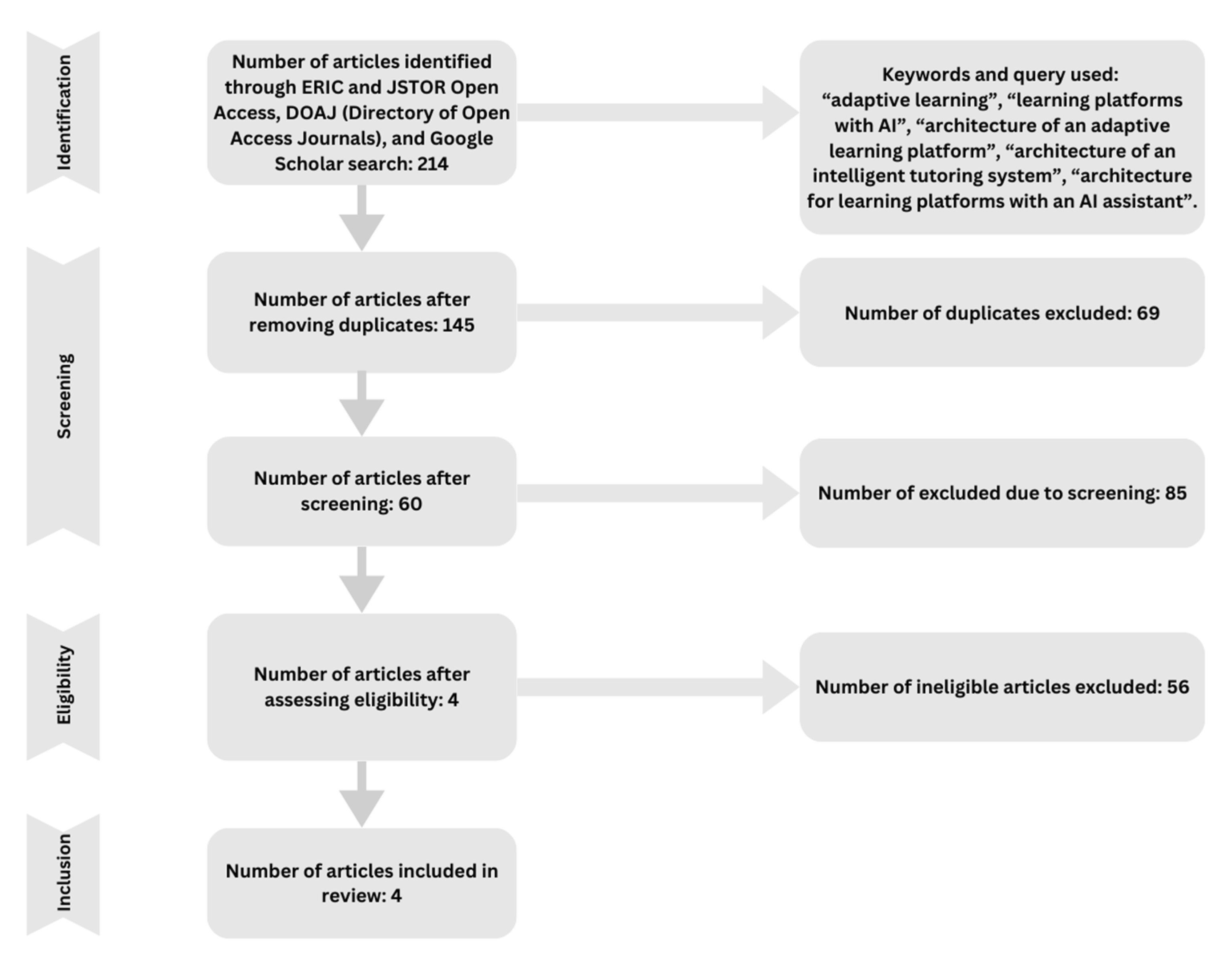
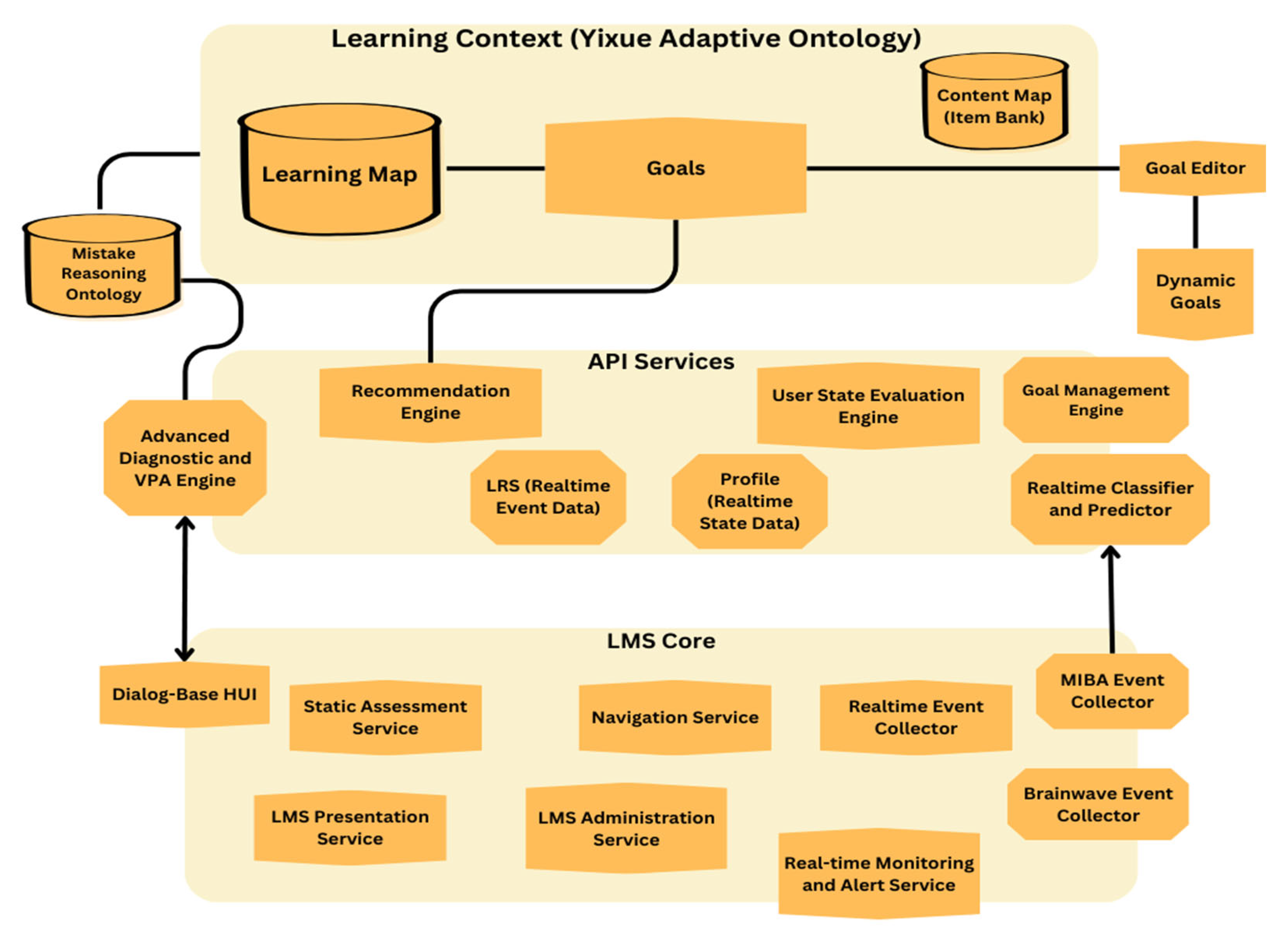
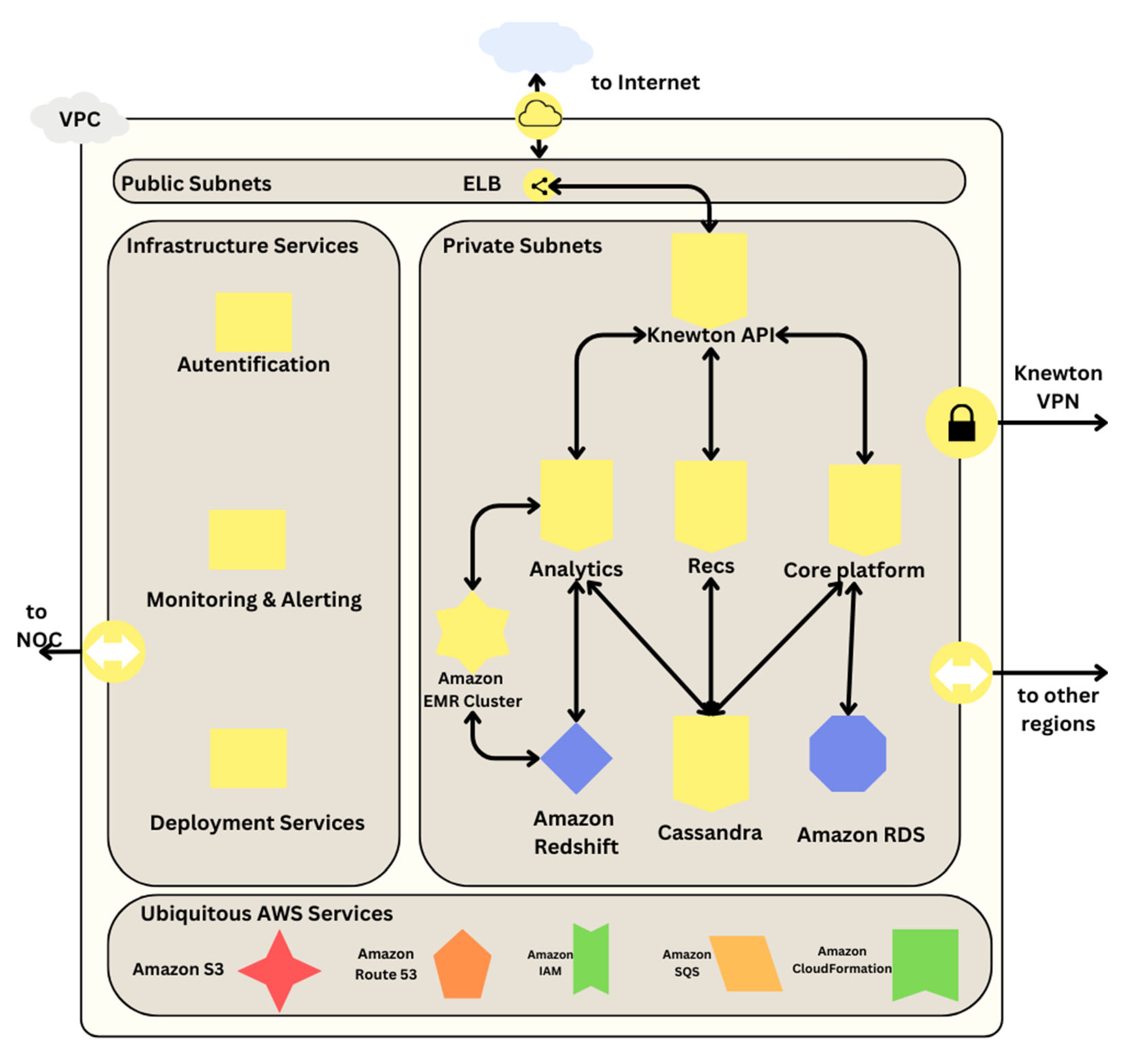
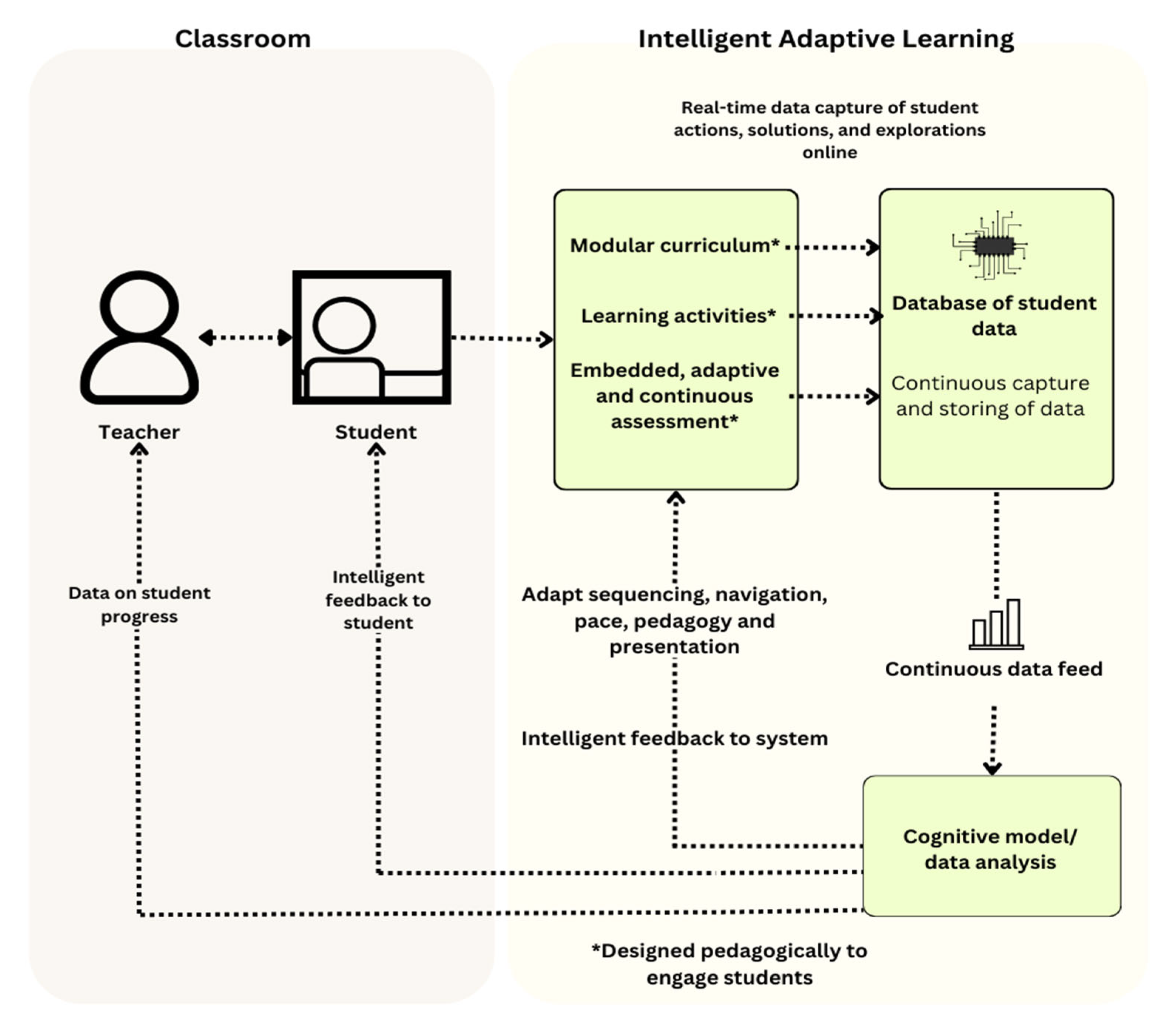
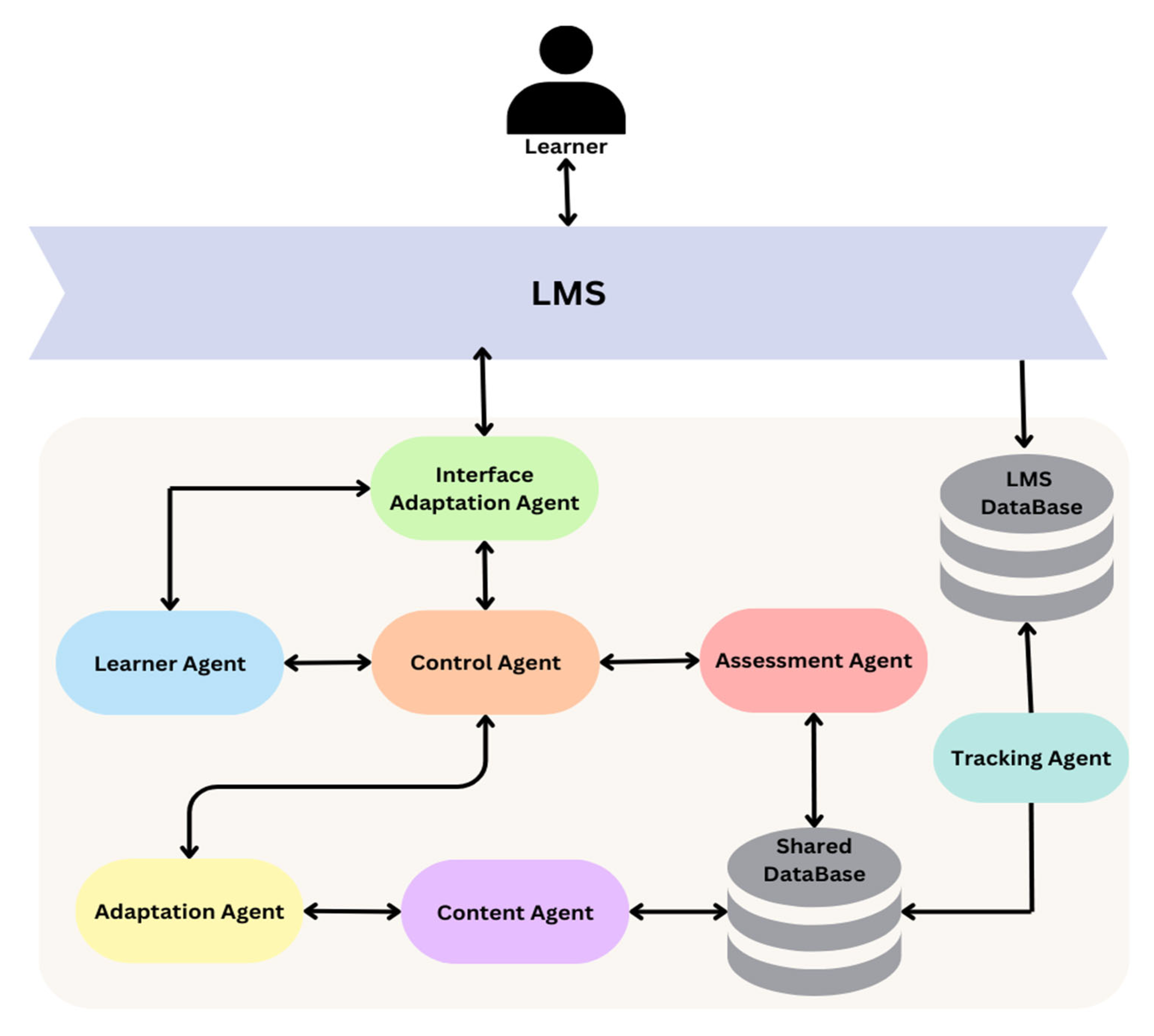
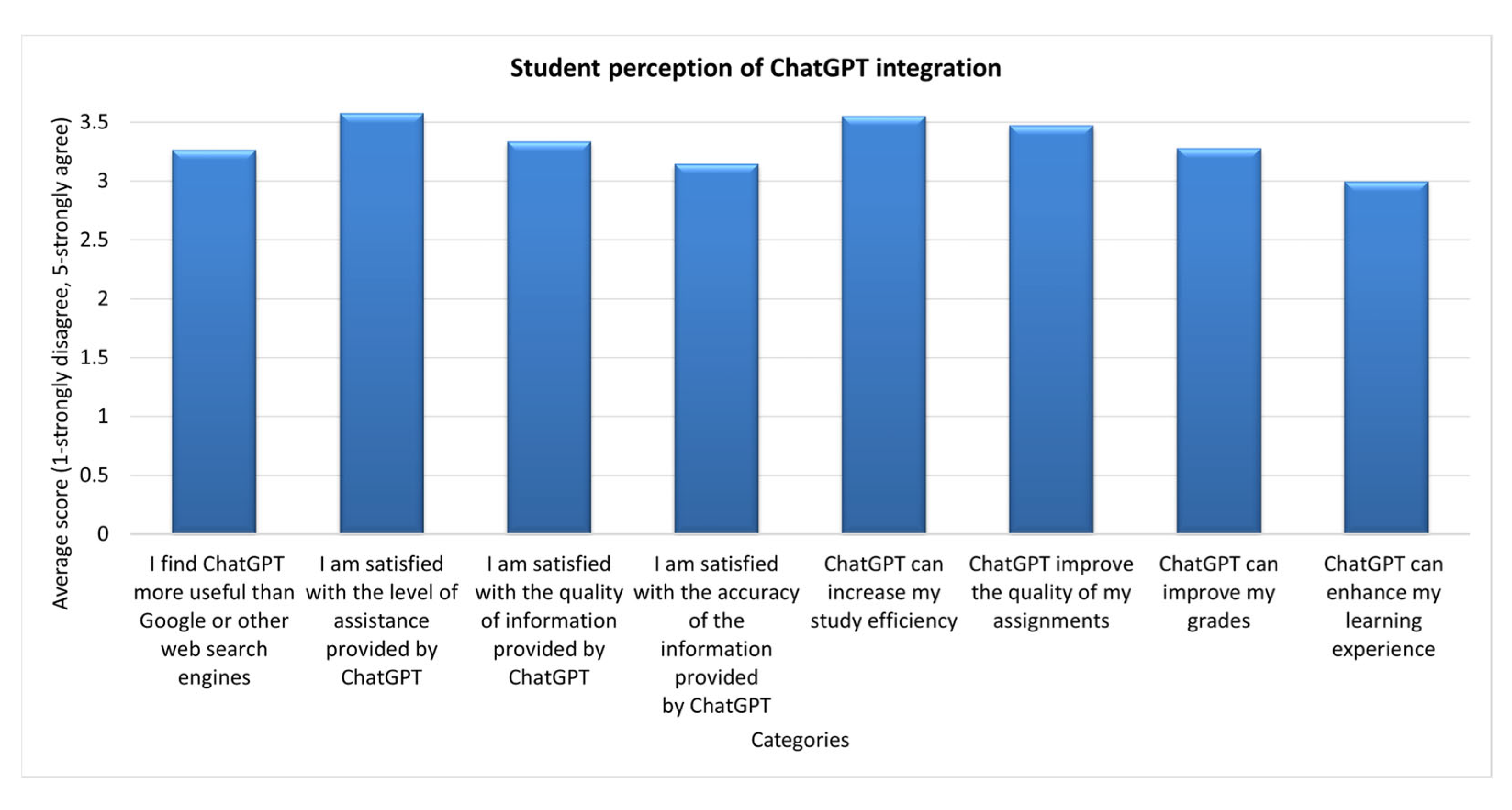
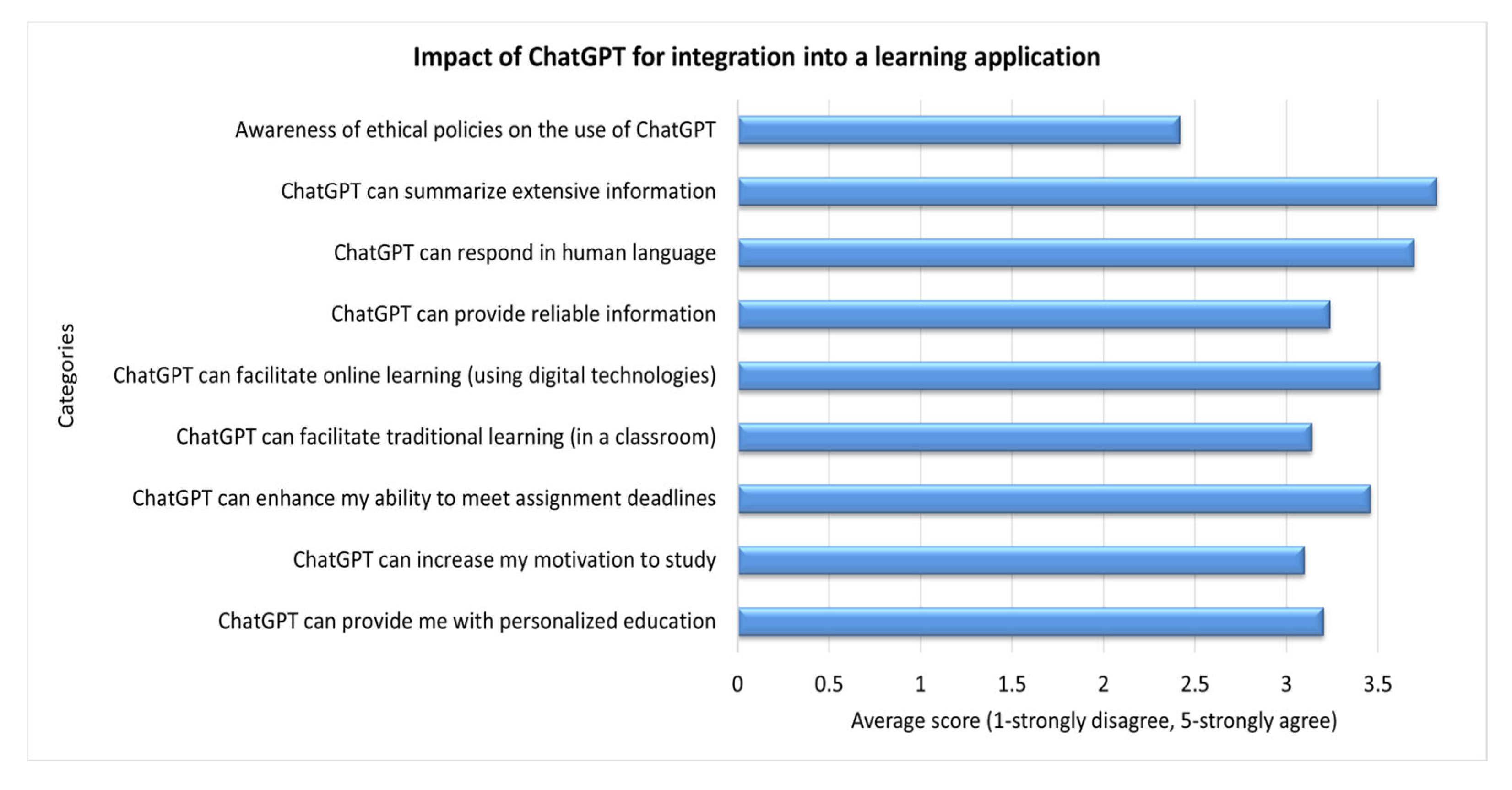
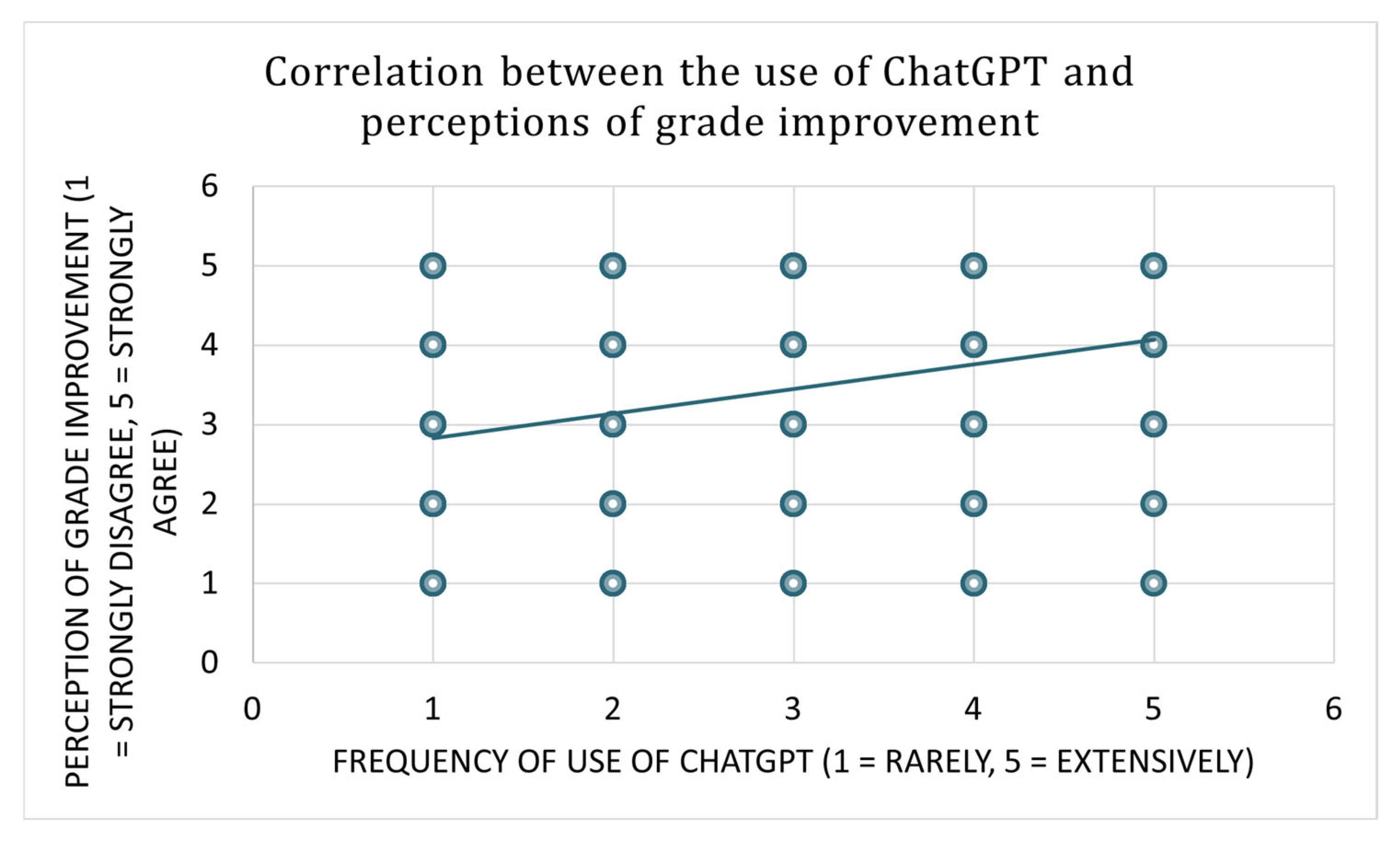
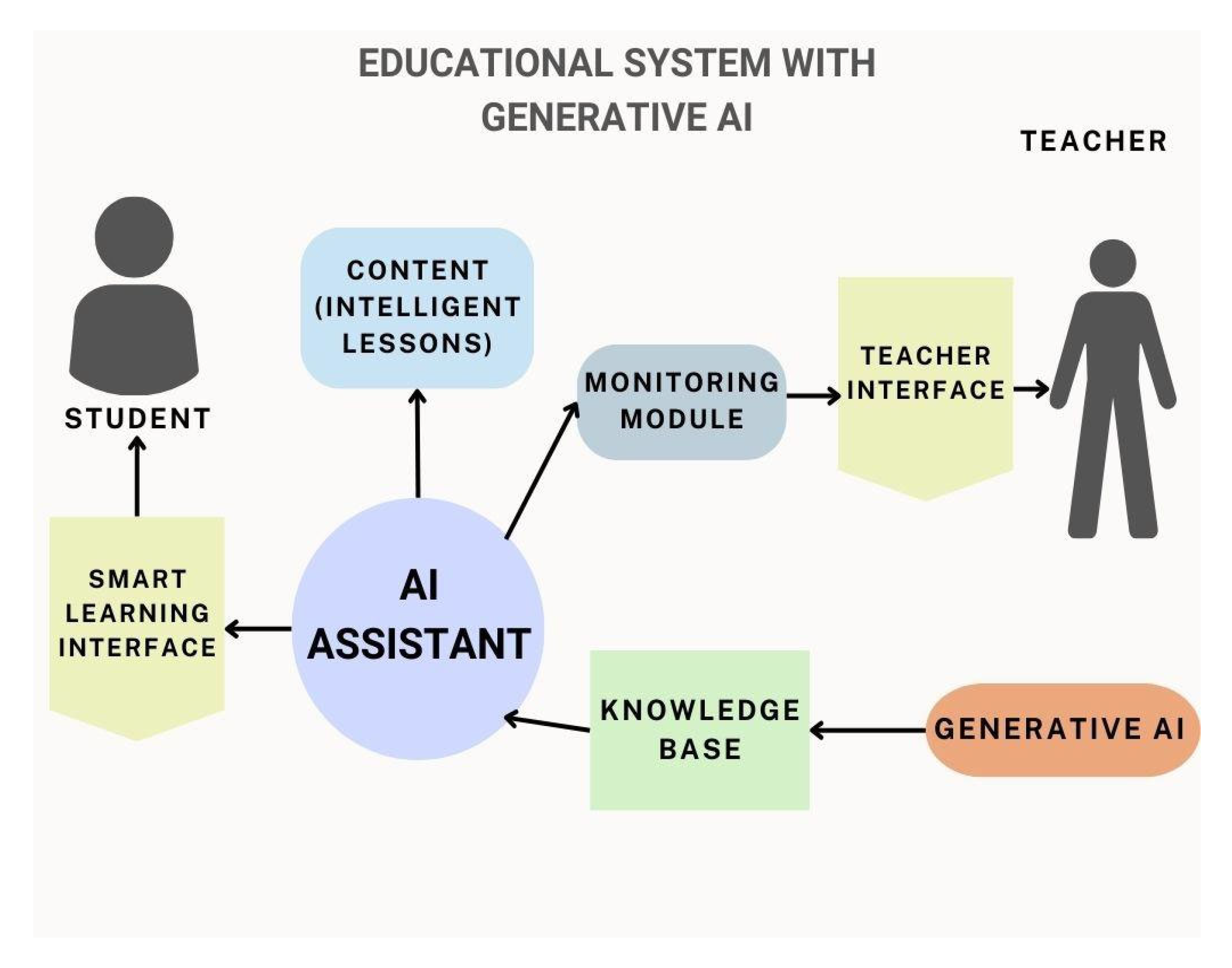
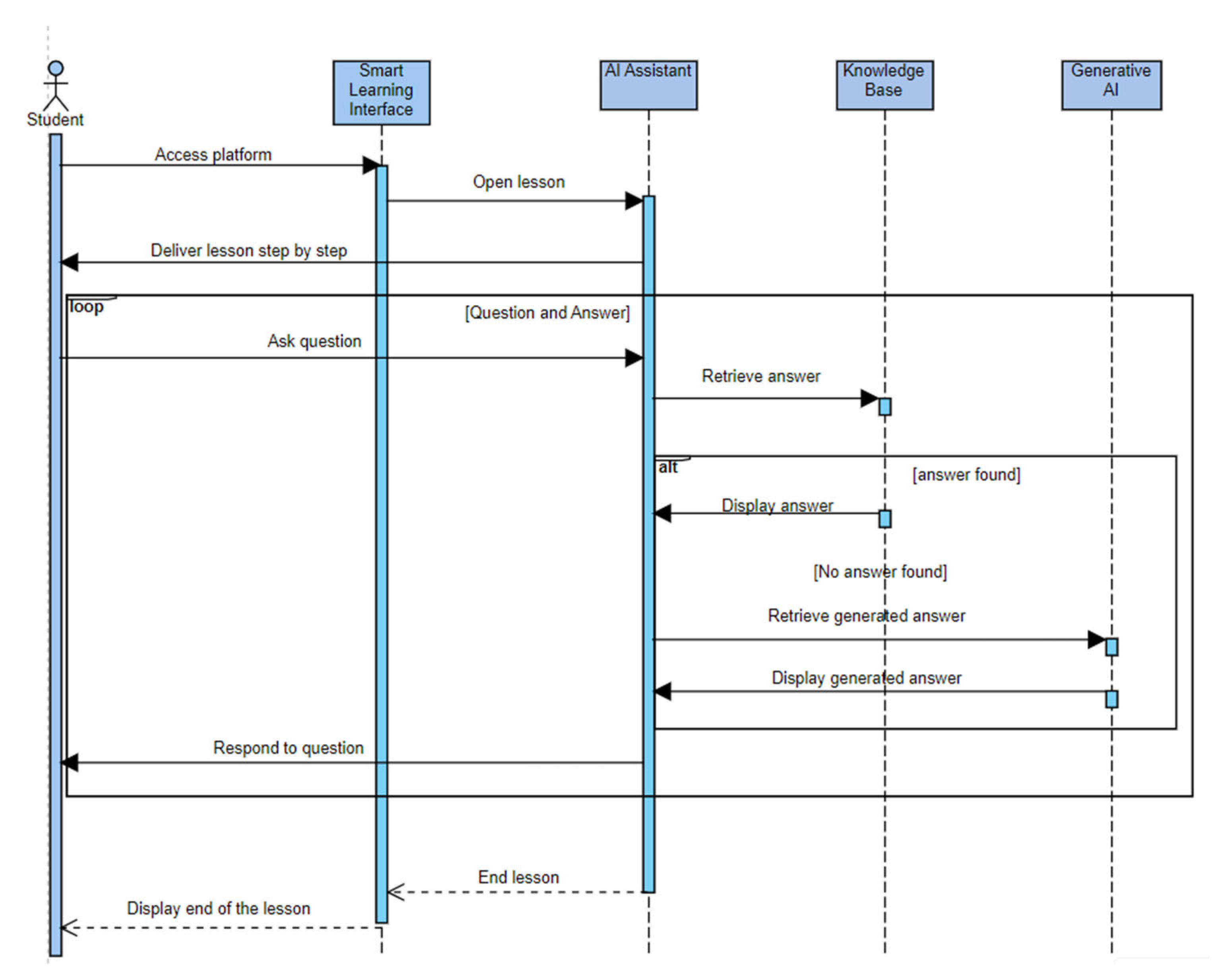
| Name of the Platform | Adaptivity and Personalization Mechanisms | Artificial Intelligence Mechanism | Focus Domains | Target Audience |
|---|---|---|---|---|
| Squirrel AI | AI-based teacher | AI algorithms, large adaptive model (based on large models) | K-12 Subjects | K-12 students |
| Knewton | Content-focused | AI algorithms | K-12 subjects (math, science, English, history). | K-12 students |
| DreamBox | Content-focused | Cognitive model | Mathematics and reading | PreK-12 students |
| Multi-agent system | Content-focused | Q-learning algorithm | Not specified | Not specified (students) |
Disclaimer/Publisher’s Note: The statements, opinions and data contained in all publications are solely those of the individual author(s) and contributor(s) and not of MDPI and/or the editor(s). MDPI and/or the editor(s) disclaim responsibility for any injury to people or property resulting from any ideas, methods, instructions or products referred to in the content. |
© 2025 by the authors. Licensee MDPI, Basel, Switzerland. This article is an open access article distributed under the terms and conditions of the Creative Commons Attribution (CC BY) license (https://creativecommons.org/licenses/by/4.0/).
Share and Cite
Mirea, C.-M.; Bologa, R.; Toma, A.; Clim, A.; Plăcintă, D.-D.; Bobocea, A. Transforming Learning with Generative AI: From Student Perceptions to the Design of an Educational Solution. Appl. Sci. 2025, 15, 5785. https://doi.org/10.3390/app15105785
Mirea C-M, Bologa R, Toma A, Clim A, Plăcintă D-D, Bobocea A. Transforming Learning with Generative AI: From Student Perceptions to the Design of an Educational Solution. Applied Sciences. 2025; 15(10):5785. https://doi.org/10.3390/app15105785
Chicago/Turabian StyleMirea, Corina-Marina, Răzvan Bologa, Andrei Toma, Antonio Clim, Dimitrie-Daniel Plăcintă, and Andrei Bobocea. 2025. "Transforming Learning with Generative AI: From Student Perceptions to the Design of an Educational Solution" Applied Sciences 15, no. 10: 5785. https://doi.org/10.3390/app15105785
APA StyleMirea, C.-M., Bologa, R., Toma, A., Clim, A., Plăcintă, D.-D., & Bobocea, A. (2025). Transforming Learning with Generative AI: From Student Perceptions to the Design of an Educational Solution. Applied Sciences, 15(10), 5785. https://doi.org/10.3390/app15105785






